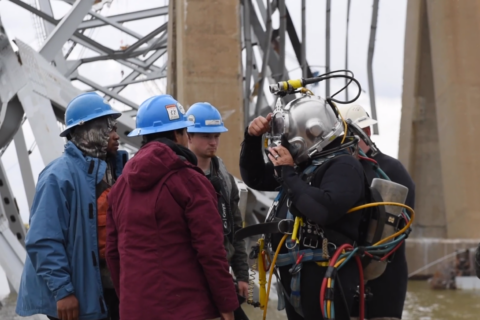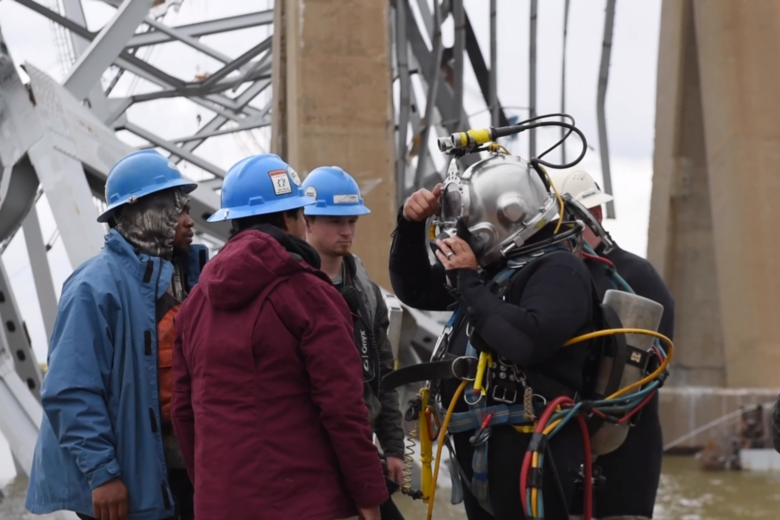
The workplace is dark, dangerous and unforgiving — divers beneath the surface of the Patapsco River, at the site of the March 26 Baltimore’s Francis Scott Key Bridge collapse, are facing a variety of life-threatening challenges, in underwater operations.
On Monday, the fourth construction worker killed in the collapse after the Key Bridge was struck by a container bridge was positively identified. When salvage teams located what they believed was a missing construction vehicle, the worker was found trapped inside.
Two construction workers’ remains have yet to be located.
The risks to divers are severe, according to Rick Benoit, an emergency management specialist with the U.S. Army Corps of Engineers North Atlantic Division. Benoit is advising the Army Corps’ joint effort with the U.S. Navy’s Supervisor of Salvage and Diving, overseeing the commercial dive companies working underwater.
“Beneath those waters, divers are moving as if playing an underwater game of Twister and Jenga with hundreds of tons of shattered concrete and twisted steel in complete darkness,” Benoit said in an Army Corps blog post.
If the divers don’t proceed with caution, Benoit said they could be impaled by rebar, cut by jagged steel, or hit by falling, broken pieces of concrete or asphalt.
With visibility limited to 1 or 2 feet in front of them, they rely on survey data from lidar and sonar imaging tools to help map out underwater routes. Even with those tools, danger remains — rebar can’t be located by sonar, according to the Army Corps.
Divers have to be wary of stepping on the bottom of the Patapsco River, as the riverbed is muddy, silty and embedded with wreckage.
Water temperatures have hovered around 48 degrees since the start of the operation, which is cold enough to cause a diver to experience hypothermia after an hour in the water, depending upon the type of suit being worn and the depth the diver is working at, according to the Army Corps.
“The divers in Baltimore Harbor are diving as far down as 50 feet. In a typical dive at that depth, a person would have approximately 92 minutes in dive time. As a safety measure, divers in the Harbor are restricted to 45 minutes underwater,” according to the Army Corps blog post.
Staying underwater longer than the advised time also increases the risk of decompression sickness, or “the bends.” Recompression chambers sit on barges on-site, as an emergency precaution.
Before the wreckage can be removed, divers have to survey and investigate the safest way to remove it. Large pieces of steel beams have to be cut.
“If you take a rubber band, twist it enough times and then cut it, what happens? It’ll snap back on you,” Benoit said. “The steel has been twisted in an opposite way than it was intended to exist, so it’s trying to get back to its original dimension. When you start cutting into it, it is like cutting a branch off a tree. You get to a certain point where inertia takes over and it snaps.”
Benoit said there’s the risk the entire structure could move, due to the release of force on that section of beam.
In the event salvage divers locate what they believe to be human remains, Maryland State Police and public safety divers take over the process of recovering them.
EDITOR’S NOTE: This story has been updated to clarify Rick Benoit’s role with the U.S. Army Corps of Engineers.
Get breaking news and daily headlines delivered to your email inbox by signing up here.
© 2024 WTOP. All Rights Reserved. This website is not intended for users located within the European Economic Area.









